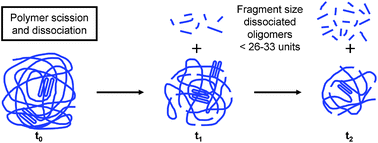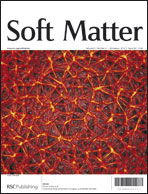Structure of hyaluronan during acid-catalyzed hydrolysis, a kinetic study of both chain scission and disaggregation†
Abstract
Aqueous hyaluronan (HA) solutions were hydrolyzed at pH 1.1, at various temperatures, and followed by (1) determining the increase in concentration of reducing sugar ends, and by (2) measuring the reduction in light-scattering intensity. The first method measures the chain scissions per unit time. The second method measures the change in particle size in time. From the determined chain scission rate, the evolution of the weight-averaged molecular mass of chains can be calculated. Under the assumption that the formed chain fragments immediately dissociate from the parent particle this would be equal to the evolution of the particle mass. However, the observed decay of light-scattering intensity relates to a much slower decrease of weight-averaged particle mass than predicted. Therefore, chain scission does not necessarily lead to immediate particle dissociation. Temperature-dependent measurements show that both chain scission and dissociation have similar


 Please wait while we load your content...
Please wait while we load your content...